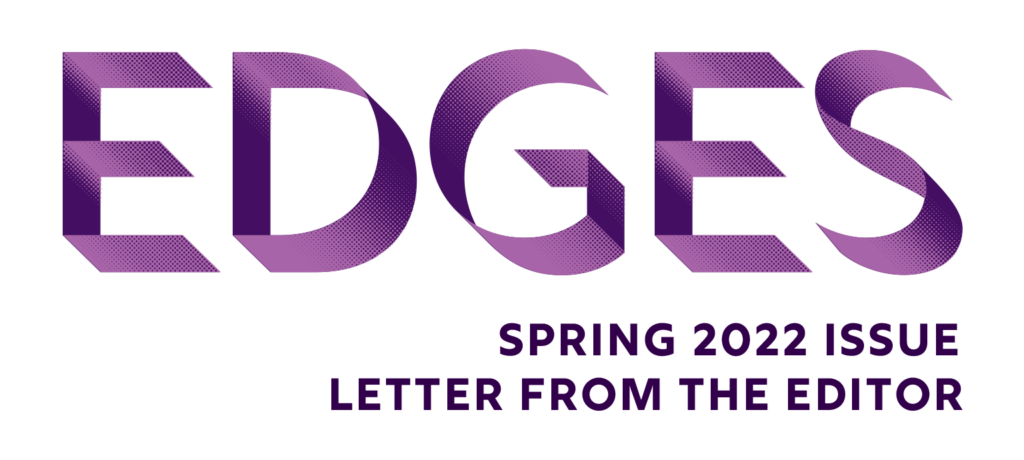
The Spring 2022 issue of the Urban Review rethinks the significance and function of edges in the urban environment. With an increasing demand for space to live, learn, work, and play, cities’ natural and man-made edges are transforming. Climate change erodes shorelines and brings deadly, extreme weather events further inland. Federal, state, and local redistricting, triggered by the release of decennial census data, manipulates the balance of power and representation. Two years after the COVID-19 outbreak, embracing a “new normal” means navigating modern frontiers like virtual socialization in the metaverse and regulation of cryptocurrencies. Major disparities in information sharing and urban infrastructure inhibit marginalized, low-income people and communities of color from meaningfully participating in our physical and virtual worlds. Cities, now more than ever, must respond to changes in our (in)tangible borders to ensure comprehensive, equitable service and resource allocation.
This semester coincided with the start of a new term for New York’s second Black mayor. Unsure what trials or opportunities this new year would offer, Hunter College students continued in-person instruction and quickly endured ever-evolving COVID-19 vaccine and mask mandates, news of the ensuing violence of Russia’s invasion of Ukraine, and rising energy costs and inflation at a 40-year high. With the backdrop of this turbulent time, the contributors to the Spring 2022 issue of the Urban Review reconsider traditional barriers historically distancing certain groups of people from the center of urban discourse.
Contributors offer unique insights to unite urban dwellers and improve the quality of urban living. Public restroom access, or the lack thereof, was a shared theme for two articles. In Miranda Bellizia’s photo essay, the social importance and function of public restrooms are detailed. Restrooms not only serve a practical use, but they also provide safety and a sense of comfort in a bustling or unfamiliar city. Maria Rocha-Buschel closely analyzes the economic and political factors that have prevented the construction of more public restrooms in major cities like New York. She proposes considering alternative bathroom typologies that are not only eco-friendly but economically feasible. Both pieces emphasize how the dearth of public restrooms affects all city dwellers, especially individuals experiencing homelessness.
Three authors examine the transportation infrastructure in and around the New York City metropolitan area. From a cyclist’s perspective, Gregory Suter takes us along for his 2,131st Citi Bike ride through several Queens neighborhoods. This narrative photo essay depicts hazards of poor bike infrastructure and the disparities of transit options on the fringes of the Citi Bike zone. Benjamin Freiman spent several weeks capturing the essence of the Metro North’s northern-, eastern-, and western-most stops. This photo essay explores how the physical and cultural influence of a major metropolis decays the further you travel from it. Meredith Lyon investigates the relationship between Citi Bike and subway ridership in New York City. The focus of this piece is how the location (and even existence) of last mile transit options complements usage of nearby subway stations.
Other contributors thoughtfully weigh the benefits and consequences of man-made and socially enforced boundaries. Jennifer Hendricks utilizes Emmanuel Monzon’s photo series to reflect on the spaces created in the wake of urban sprawl. This piece highlights the growth of inorganic landscapes and draws commonalities between urban and rural sprawl. Matthew Choi’s cheeky photo essay challenges the ambiguity of “acceptable” behavior in public spaces. He demonstrates that it is often the person doing an activity, not necessarily the action itself, that is perceived and policed as a nuisance or not. Kathleen Ross offers an in-depth evaluation of trees as more than just a means for urban beautification, but as essential infrastructure. This article further proposes that civic stewardship, alone, cannot sustain or scale up the resources needed to manage green infrastructure.
Contributors to this issue present the challenges that exist in urban spaces where people, nature, and inanimate things are forced to converge and interact every day. They also introduce new perspectives and unconventional ways to better understand and improve our changing landscapes. An edge is the place where one thing ends and another starts. We hope, after reading the eight articles in this issue, you are inspired to learn more about your communities and seek opportunities to serve them.
Jaclyn Williams, Editor-in-Chief
Jaclyn Williams is a graduate of the M.S. in Urban Policy and Leadership program at Hunter College (’22). Born and raised in New York City, she developed deep interests in individual agency, neighborhood cohesion, and housing and economic development in metropolitan areas. Connect with her on LinkedIn at www.linkedin.com/in/jaclynewilliams.

